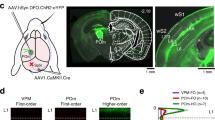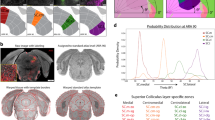Abstract
THREE main areas within the diencephalon are known to be concerned with somatosensory mechanisms; these are the ventrobasal complex, the intralaminar complex, and the posterior group. It is generally accepted that the afferents to the ventrobasal complex are organized in a simple somatotopic fashion1,2, whereas the input to the intralaminar complex3,4 and to the posterior group4,5 is non-somatotopic and generally of long latency. The arrangement of afferents to the ventrobasal complex may be more complex than previously supposed6,7, and the lateral thalamic nuclei may also be involved in somatosensory activity7. Furthermore, the properties of the nuclei of the dorsal column show a rostro-caudal differentiation8,9, and it has been suggested that this is reflected in a differential termination of the medial lemniscus10. We have investigated the distribution of degeneration in the rat diencephalon using the Nauta method11,12 after lesions made separately in the gracile and cuneate nuclei, the spinal cord at different levels from the spinomedullary junction to the lumbar region, and the trigeminal nuclear complex.
This is a preview of subscription content, access via your institution
Access options
Subscribe to this journal
Receive 51 print issues and online access
$199.00 per year
only $3.90 per issue
Buy this article
- Purchase on Springer Link
- Instant access to full article PDF
Prices may be subject to local taxes which are calculated during checkout
Similar content being viewed by others
References
Mountcastle, V. B., and Henneman, E., J. Comp. Neurol., 97, 409 (1952)
Rose, J. E., and Mountcastle, V. B., J. Comp. Neurol., 97, 441 (1952).
Kruger, L., and Albe-Fessard, D., Exp. Neurol., 2, 442 (1960).
Whitlock, D. G., and Perl, E. R., Exp. Neurol., 3, 240 (1961).
Poggio, G. F., and Mountcastle, V. B., Bull. Johns Hopkins Hosp., 106, 266 (1960).
Emmers, R., J. Comp. Neurol., 124, 215 (1965).
Landgren, S., Nordwall, A., and Wengström, C., Acta Physiol. Scand., 65, 164 (1965).
Gordon, G., and Jukes, M. G. M., J. Physiol., 173, 263 (1964).
McComas, A. J., J. Physiol., 166, 435 (1963).
Kuypers, H. G. J. M., and Tuerk, J. C., J. Anat., 98, 143 (1964). Hand, P., and Liu, C. N., Anat. Rec., 154, 353 (1966).
Nauta, W. J. H., and Gygax, P. A., Stain Technol., 29, 91 (1954).
Guillery, R. W., Shirra, B., and Webster, K. E., Stain Technol., 36, 9 (1961).
Mehler, W. R., Fefferman, M. E., and Nauta, W. J. H., Brain, 83, 718 (1960).
Mehler, W. R., in The Thalamus (edit. by Purpura, D. P., and Yahr, M. D.), 109 (Columbia Univ. Press, 1966).
Poggio, G. F., and Mountcastle, V. B., J. Neurophysiol., 26, 775 (1963).
Morin, F., and Thomas, L. M., Anat. Rec., 121, 344 (1955).
Andersen, F. D., and Berry, C. M., J. Comp. Neurol., 111, 195 (1959).
Author information
Authors and Affiliations
Rights and permissions
About this article
Cite this article
WEBSTER, K., LUND, R. Organization of Somatic Afferents to the Diencephalon. Nature 215, 428–429 (1967). https://doi.org/10.1038/215428a0
Received:
Issue Date:
DOI: https://doi.org/10.1038/215428a0
Comments
By submitting a comment you agree to abide by our Terms and Community Guidelines. If you find something abusive or that does not comply with our terms or guidelines please flag it as inappropriate.



